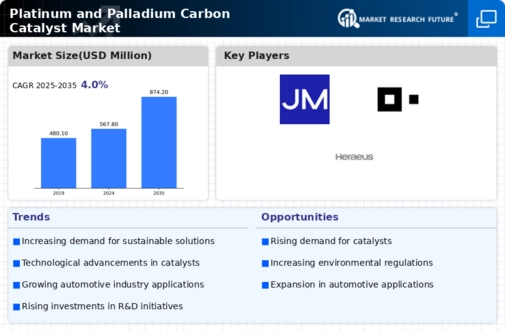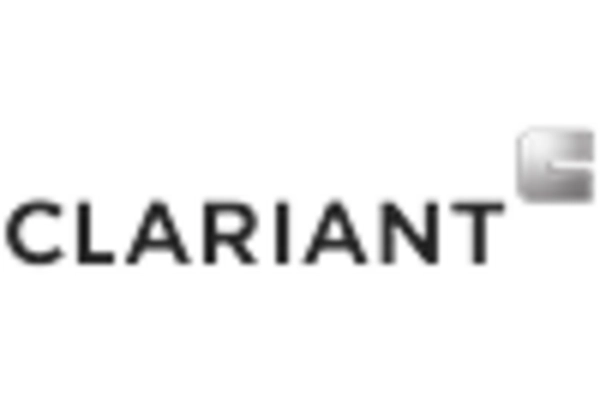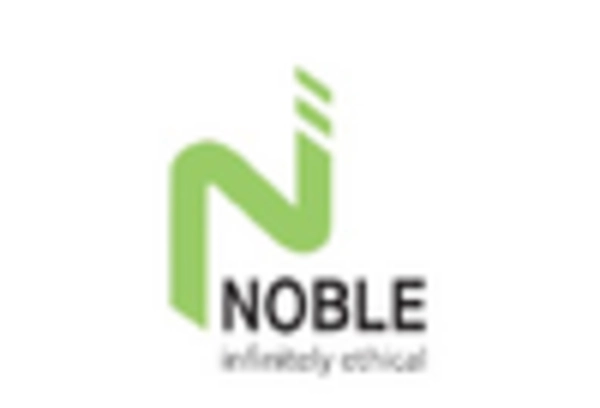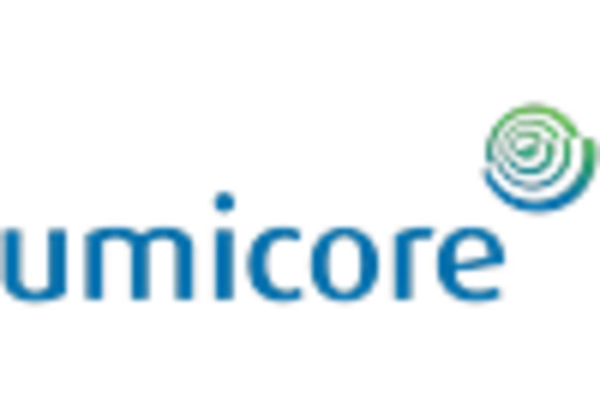-
Executive Summary
-
Market Introduction
-
Market Definition
-
Scope of the Study
-
List of Assumptions
-
Markets Structure
-
Market Research Methodology
-
Research Process
-
Primary Research
-
Secondary Research
-
Market Size Estimation
-
Forecast Model
-
Market Dynamics of Global Platinum- and Palladium-Carbon Catalyst Market
-
Introduction
-
Drivers
-
Restraints
-
Opportunities
-
Challenges
-
Market Factor Analysis of Global Platinum- and Palladium-Carbon Catalyst Market
-
Supply Chain Analysis
- Raw Material Suppliers
- Manufacturers/Producers
- Distributors/Retailers/Wholesalers/E-Commerce
- End User
-
Porter’s Five Forces Analysis
- Threat of New Entrants
- Bargaining Power of Buyers
- Bargaining Power of Suppliers
- Threat of Substitutes
- Intensity of Competitive Rivalry
-
Pricing Analysis
-
Global Platinum- and Palladium-Carbon Catalyst Market, by Metal
-
Introduction
-
Platinum Carbon Catalyst
- Market Estimates & Forecast, 2020−2027
- Market Estimates & Forecast, by Region, 2020−2027
-
Palladium-Carbon Catalyst
- Market Estimates & Forecast, 2020−2027
- Market Estimates & Forecast, by Region, 2020−2027
-
Global Platinum- and Palladium-Carbon Catalyst Market, by End-Use Industry
-
Introduction
-
Automotive
- Market Estimates & Forecast, 2020−2027
- Market Estimates & Forecast, by Region, 2020−2027
-
Chemical
- Market Estimates & Forecast, 2020−2027
- Market Estimates & Forecast, by Region, 2020−2027
-
Aerospace
- Market Estimates & Forecast, 2020−2027
- Market Estimates & Forecast, by Region, 2020−2027
-
Pharmaceuticals
- Market Estimates & Forecast, 2020−2027
- Market Estimates & Forecast, by Region, 2020−2027
-
Others
- Market Estimates & Forecast, 2020−2027
- Market Estimates & Forecast, by Region, 2020−2027
-
Global Platinum- and Palladium-Carbon Catalyst Market, by Region
-
Introduction
-
North America
- Market Estimates & Forecast, 2020−2027
- Market Estimates & Forecast, by Metal, 2020−2027
- Market Estimates & Forecast, by End-Use Industry, 2020−2027
- US
- Canada
-
Europe
- Market Estimates & Forecast, 2020−2027
- Market Estimates & Forecast, by Metal, 2020−2027
- Market Estimates & Forecast, by End-Use Industry, 2020−2027
- Germany
- France
- Italy
- Spain
- UK
- Russia
- Poland
- Rest of Europe
-
Asia-Pacific
- Market Estimates & Forecast, 2020−2027
- Market Estimates & Forecast, by Metal, 2020−2027
- Market Estimates & Forecast, by End-Use Industry, 2020−2027
- China
- India
- Japan
- Australia & New Zealand
- Rest of Asia-Pacific
-
Middle East & Africa
- Market Estimates & Forecast, 2020−2027
- Market Estimates & Forecast, by Metal, 2020−2027
- Market Estimates & Forecast, by End-Use Industry, 2020−2027
- GCC
- Israel
- North Africa
- Turkey
- Rest of Middle East & Africa
-
Latin America
- Market Estimates & Forecast, 2020−2027
- Market Estimates & Forecast, by Metal, 2020−2027
- Market Estimates & Forecast, by End-Use Industry, 2020−2027
- Brazil
- Argentina
- Mexico
- Rest of Latin America
-
Company Landscape
-
Introduction
-
Market Strategy
-
Key Development Analysis (Expansion/Merger & Acquisitions/Joint Venture/New Product Development/Agreement/Investment)
-
Company Profiles
-
BASF SE
- Company Overview
- Financial Updates
- Product/Business Segment Overview
- Strategy
- Key Developments
- SWOT Analysis
-
Evonik Industries AG
- Company Overview
- Financial Updates
- Product/Business Segment Overview
- Strategy
- Key Developments
- SWOT Analysis
-
Clariant AG
- Company Overview
- Financial Updates
- Product/Business Segment Overview
- Strategy
- Key Developments
- SWOT Analysis
-
Johnson Matthey
- Company Overview
- Financial Updates
- Product/Business Segment Overview
- Strategy
- Key Developments
- SWOT Analysis
-
KaiDa Chemicals
- Company Overview
- Financial Updates
- Product/Business Segment Overview
- Strategy
- Key Developments
- SWOT Analysis
-
Vineeth Precious Catalysts Pvt. Ltd
- Company Overview
- Financial Updates
- Product/Business Segment Overview
- Strategy
- Key Developments
- SWOT Analysis
-
American Elements
- Company Overview
- Financial Updates
- Product/Business Segment Overview
- Strategy
- Key Developments
- SWOT Analysis
-
Chimet S.p.A.
- Company Overview
- Financial Updates
- Product/Business Segment Overview
- Strategy
- Key Developments
- SWOT Analysis
-
Sabin Metal Corporation
- Company Overview
- Financial Updates
- Product/Business Segment Overview
- Strategy
- Key Developments
- SWOT Analysis
-
Umicore N.V.
- Company Overview
- Financial Updates
- Product/Business Segment Overview
- Strategy
- Key Developments
- SWOT Analysis
-
FUJIFILM Wako Pure Chemical Corporation
- Company Overview
- Financial Updates
- Product/Business Segment Overview
- Strategy
- Key Developments
- SWOT Analysis
-
Alfa Aesar
- Company Overview
- Financial Updates
- Product/Business Segment Overview
- Strategy
- Key Developments
- SWOT Analysis
-
Heraeus Group
- Company Overview
- Financial Updates
- Product/Business Segment Overview
- Strategy
- Key Developments
- SWOT Analysis
-
Shanxi Kaida Chemcial Engineering Co., Ltd
- Company Overview
- Financial Updates
- Product/Business Segment Overview
- Strategy
- Key Developments
- SWOT Analysis
-
Shaanxi Kaida Chemical Engineering Co., Ltd
- Company Overview
- Financial Updates
- Product/Business Segment Overview
- Strategy
- Key Developments
- SWOT Analysis
-
Conclusion
-
-
LIST OF TABLES
-
Global Platinum- and Palladium-Carbon Catalyst Market: by Region, 2020−2027
-
North America: Platinum- and Palladium-Carbon Catalyst Market, by Country, 2020−2027
-
Europe: Platinum- and Palladium-Carbon Catalyst Market, by Country, 2020−2027
-
Asia-Pacific: Platinum- and Palladium-Carbon Catalyst Market. by Country, 2020−2027
-
Middle East & Africa: Platinum- and Palladium-Carbon Catalyst Market, by Country, 2020−2027
-
Latin America: Platinum- and Palladium-Carbon Catalyst Market, by Country, 2020−2027
-
Global Platinum- and Palladium-Carbon Catalyst Metal Market, by Regions, 2020−2027
-
North America: Platinum- and Palladium-Carbon Catalyst Metal Market, by Country, 2020−2027
-
Europe: Platinum- and Palladium-Carbon Catalyst Metal Market, by Country, 2020−2027
-
Table10 Asia-Pacific: Platinum- and Palladium-Carbon Catalyst Metal Market, by Country, 2020−2027
-
Table11 Middle East & Africa: Platinum- and Palladium-Carbon Catalyst Metal Market, by Country, 2020−2027
-
Table12 Latin America: Platinum- and Palladium-Carbon Catalyst Metal Market, by Country, 2020−2027
-
Global Platinum- and Palladium-Carbon Catalyst End-Use Industry Market, by Regions, 2020−2027
-
Table14 North America: Platinum- and Palladium-Carbon Catalyst End-Use Industry Market, by Country, 2020−2027
-
Table15 Europe: Platinum- and Palladium-Carbon Catalyst End-Use Industry Market, by Country, 2020−2027
-
Table16 Asia-Pacific: Platinum- and Palladium-Carbon Catalyst End-Use Industry Market, by Country, 2020−2027
-
Table17 Middle East & Africa: Platinum- and Palladium-Carbon Catalyst End-Use Industry Market, by Country, 2020−2027
-
Table18 Latin America: Platinum- and Palladium-Carbon Catalyst by End-Use Industry Market, by Country, 2020-2027
-
Table19 Global Metal Market, by Region, 2020−2027
-
Table20 Global End-Use Industry Market, by Region, 2020−2027
-
Table21 North America: Platinum- and Palladium-Carbon Catalyst Market, by Country, 2020−2027
-
Table22 North America: Platinum- and Palladium-Carbon Catalyst Market, by Metal, 2020−2027
-
Table23 North America: Platinum- and Palladium-Carbon Catalyst Market, by End-Use Industry, 2020−2027
-
Table24 Europe: Platinum- and Palladium-Carbon Catalyst Market, by Country, 2020−2027
-
Table25 Europe: Platinum- and Palladium-Carbon Catalyst Market, by Metal, 2020−2027
-
Table26 Europe: Platinum- and Palladium-Carbon Catalyst Market, by End-Use Industry, 2020−2027
-
Table27 Asia-Pacific: Platinum- and Palladium-Carbon Catalyst Market, by Country, 2020−2027
-
Table28 Asia-Pacific: Platinum- and Palladium-Carbon Catalyst Market, by Metal, 2020−2027
-
Table29 Asia-Pacific: Platinum- and Palladium-Carbon Catalyst Market, by End-Use Industry, 2020−2027
-
Table30 Middle East & Africa: Platinum- and Palladium-Carbon Catalyst Market, by Country, 2020−2027
-
Table31 Middle East & Africa: Platinum- and Palladium-Carbon Catalyst Market, by Metal, 2020−2027
-
Table32 Middle East & Africa: Platinum- and Palladium-Carbon Catalyst Market, by End-Use Industry, 2020−2027
-
Table33 Latin America: Platinum- and Palladium-Carbon Catalyst Market, by Country, 2020−2027
-
Table34 Latin America: Platinum- and Palladium-Carbon Catalyst Market, by Metal, 2020−2027
-
Table35 Latin America: Platinum- and Palladium-Carbon Catalyst Market, by End-Use Industry, 2020−2027
-
-
LIST OF FIGURES
-
Global Platinum- and Palladium-Carbon Catalyst Market Segmentation
-
Forecast Research Methodology
-
Five Forces Analysis of Global Platinum- and Palladium-Carbon Catalyst Market
-
Value Chain of Global Platinum- and Palladium-Carbon Catalyst Market
-
Share of Global Platinum- and Palladium-Carbon Catalyst Market in 2020, by Country
-
Global Platinum- and Palladium-Carbon Catalyst Market, 2020−2027,
-
Global Platinum- and Palladium-Carbon Catalyst Market Size, by Metal, 2020
-
Share of Global Platinum- and Palladium-Carbon Catalyst Market, by Metal, 2020−2027
-
Global Platinum- and Palladium-Carbon Catalyst Market Size, by End-Use Industry, 2020
-
FIGURE10 Share of Global Platinum- and Palladium-Carbon Catalyst Market, by End-Use Industry, 2020−2027

















Leave a Comment